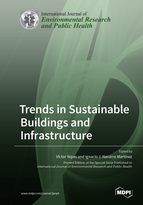Trends in Sustainable Buildings and Infrastructure
A special issue of International Journal of Environmental Research and Public Health (ISSN 1660-4601). This special issue belongs to the section "Environmental Science and Engineering".
Deadline for manuscript submissions: closed (31 October 2020) | Viewed by 39466
Special Issue Editors
Interests: multiobjective optimization; life cycle assessment; multicriteria decision-making; sustainability
Special Issues, Collections and Topics in MDPI journals
Interests: multicriteria decision making; reliability-based maintenance optimization; sustainability of infrastructures; social impacts of infrastructures
Special Issues, Collections and Topics in MDPI journals
Special Issue Information
Dear Colleagues,
The recently established Sustainable Development Goals call for a paradigm shift in the way buildings and infrastructures are conceived. The construction industry is a main source of environmental impacts, given its great material consumption and energy demands. It is also a major contributor to the economic growth of regions through the provision of useful infrastructure and generation of employment, among others. Conventional approaches underlying current building design practices fall short of covering the relevant environmental and social implications derived from inappropriate design, construction, and planning. The development of adequate sustainable design strategies is therefore becoming extremely relevant with regard to the achievement of the United Nations 2030 Agenda Goals for Sustainable Development.
This Special Issue aims to increase knowledge on sustainable design practices by highlighting the actual research trends that explore efficient ways to reduce the environmental consequences related to the construction industry while promoting social wellbeing and economic development. These objectives include but are not limited to:
- Life-cycle-oriented building and infrastructure design;
- Design optimization based on sustainable criteria;
- Maintenance design towards sustainability;
- Inclusion of social impacts in the design of buildings and infrastructures;
- Resilience and sustainability;
- Use of sustainable materials;
- Decision-making processes that effectively integrate economic, environmental, and social aspects.
Papers selected for this Special Issue will be subject to a rigorous peer-review procedure with the aim of rapid and wide dissemination of research results, developments, and applications.
Dr. Víctor Yepes
Dr. Ignacio J. Navarro Martínez
Guest Editors
Manuscript Submission Information
Manuscripts should be submitted online at www.mdpi.com by registering and logging in to this website. Once you are registered, click here to go to the submission form. Manuscripts can be submitted until the deadline. All submissions that pass pre-check are peer-reviewed. Accepted papers will be published continuously in the journal (as soon as accepted) and will be listed together on the special issue website. Research articles, review articles as well as short communications are invited. For planned papers, a title and short abstract (about 100 words) can be sent to the Editorial Office for announcement on this website.
Submitted manuscripts should not have been published previously, nor be under consideration for publication elsewhere (except conference proceedings papers). All manuscripts are thoroughly refereed through a single-blind peer-review process. A guide for authors and other relevant information for submission of manuscripts is available on the Instructions for Authors page. International Journal of Environmental Research and Public Health is an international peer-reviewed open access monthly journal published by MDPI.
Please visit the Instructions for Authors page before submitting a manuscript. The Article Processing Charge (APC) for publication in this open access journal is 2500 CHF (Swiss Francs). Submitted papers should be well formatted and use good English. Authors may use MDPI's English editing service prior to publication or during author revisions.
Keywords
- Sustainable design and construction
- Life cycle assessment
- Sustainability in decision making
- Green buildings
- Sustainable maintenance
- Resilient structures
- Sustainable materials
- Social life cycle assessment
- Sustainable management of infrastructures
- Multiobjective optimization for sustainable development







